To Contact Me


Page last updated
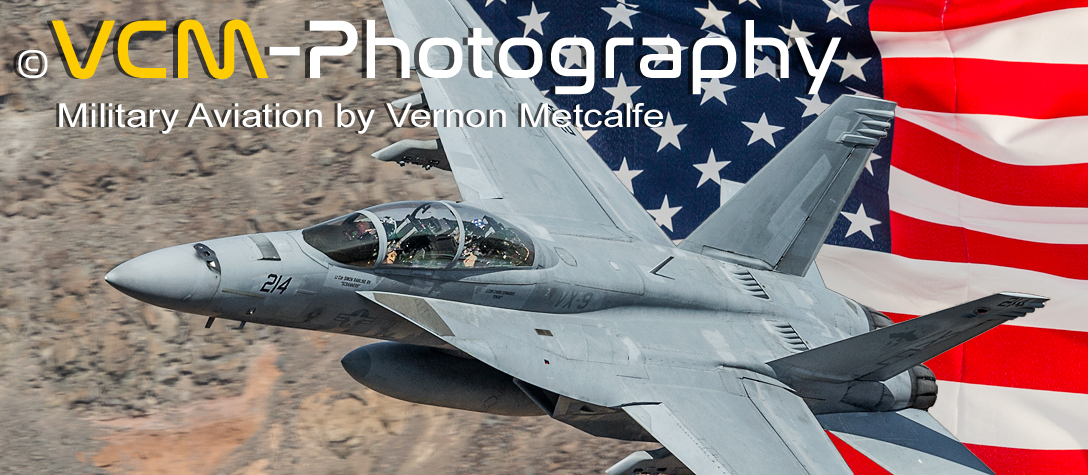
A brief description of the more commonly seen military aircraft, photographed in the USA Low Flying System.
The Northrop T-38 Talon is a two-seat, twin‑engine supersonic advanced jet trainer, introduced into service with the United
States Air Force in March 1961. The aircraft superseded the subsonic Lockheed T-33 Shooting Star and complimented the subsonic
Cessna T-37 Tweet in pilot training.
Powered by two General Electric J85-GE-5 turbojet afterburning engines, the T-38 was the world's first supersonic trainer
having a top speed of Mach 1.08 (812mph or 1,307km/h at sea level) a range of 1,093 miles (1,759km) and a maximum
ceiling above 55,000ft.
A two-seat tandem cockpit offers the student seated in the front and instructor in the rear a good all‑round view. The aircraft
engines are positioned side-by-side, with small air intakes positioned just aft of the cockpit either side of a
well-contoured aerodynamic fueslage. The small area main plains are low mounted, as are the tailplanes with a single vertical tail.
A tricycle undercarriage retracts into a relatively clean and flat belly.
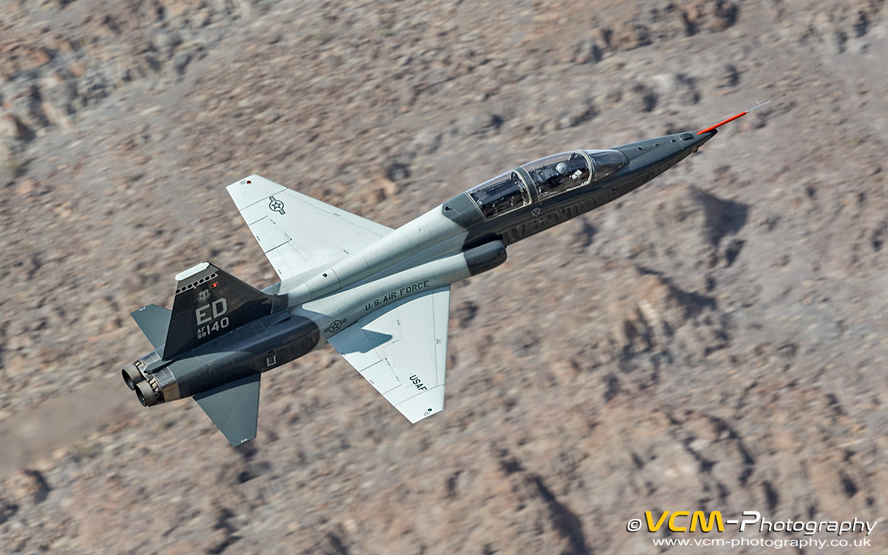 Northrop T-38C Talon of 445th Flight Test Squadron, Edwards A.F.B. United States Air Force.
Northrop T-38C Talon of 445th Flight Test Squadron, Edwards A.F.B. United States Air Force.
Most T-38's were of the T-38A variant, but a small number were designated AT-38B which were converted for
weapons training. This variant was fitted with a gunsight and could carry a gun pod, rocktes or bombs on a centreline pylon.
Begining in in the year 2000 most T-38A's and T-38B's were being converted to the T-38C as part of an
Avionics Upgrade Programme (AUP), which included an all-glass cockpit display, the addition of a head-up display (HUD),
Global Positioning System (GPS), Inertial Navigation System (INS) and a Traffic Collision Avoidance System (TCAS).
Many aircraft also received engine modifications under the Propulsion Modernization Programme (PMP), where the engines were
modified to enhance reliability and maintainability, while engine inlet/injector modifications increased available take‑off thrust.
Airframes with high usage also underwent structural replacements and upgrades, with some receiving new wings to extend their service
life to 2029.
Apart from learning aerobatics, formation flying, night instrumentation and cross-country navigation training, the T-38C allows
students to learn the advanced systems used in the modern day fighters and bombers onto which they will progress.
Being a versatile and relatively low‑cost aircraft to operate, the T-38 is used as a proficiency aircraft for U-2 and B-2 pilots
respectively and also as a training aircraft by test pilots and test engineers at the U.S. Air Force Test Pilots School at Edwards Air Force Base,
California. Air Force Material Command (AFMC) use the T-38 to test experimental equipment such as electrical weapons systems,
while NASA use it as a chase plane and trainer for astronauts and observers.
The T-38 Talon is still in service today (as of 2021) and is the most produced jet trainer, with 1,146 being built
between 1961 and 1972.
The F‑16 Fighting Falcon originally developed by General Dynamics (now Lockheed Martin) is a single‑engine supersonic
multirole fighter aircraft. Designed as an air superiority day fighter it has evolved into a successful all‑weather multirole aircraft
for the United States Air Force (USAF). As‑to‑date (2023) the F‑16 has serve in air forces of 25 other
nations and is the most numerous fixed‑wing aircraft in military service. Over 4,600 aircraft have been built since production was
approved in 1976. Though no longer purchased by the U.S. Air Force, improved versions are being built for export customers.
The origins of the F‑16 date back to the late 1960's when the United States Air Force had initiated the Lightweight Fighter (LWF)
Technology Evaluation programme to look at the concept of a light‑weight fighter, which would be highly manoeuvrable with a hight
thrust‑to‑weight ratio. The programme resulted in the development of the General Dynamics YF‑16
(first flight 2nd February 1974) and Northrop YF‑17 (nicknamed ‘Cobra’ - first flight 9th June 1974).
The YF‑16 won the competition, which developed into the F‑16 Fighting Falcon, while the Navy opted for the YF‑17, which
developed into the F/A‑18 Hornet.
The LWF programme stipulated an aircraft with a structural life of 4,000 flight hours, capable of achieving 7.33g with 80% internal fuel.
General Dynamics designed the F‑16 airframe for a life of 8,000 flight hours and allowing 9g manoeuvres on full internal fuel. This has
proved advantageous when the F‑16's mission changed from air‑to‑air combat to multirole operations. However, the changes
in operational use and additional systems have increased the aircraft weight, necessitating multiple structural strengthening programmes.
The single‑seat variant was designated F‑16A and first flew on 8th December 1976. The two‑seat variant with a tandem cockpit
was designated F‑16B and first flew on 8th August 1977. During training, the F‑16B forward cockpit is used by the student pilot,
with the instructor pilot in the rear cockpit. The first operational F‑16A was delivered to the 388th Tactical Fighter Wing at
Hill Air Force Base, Utah in January 1979, with the USAF declaring the F‑16A initial operational capability (IOC) in October 1980.
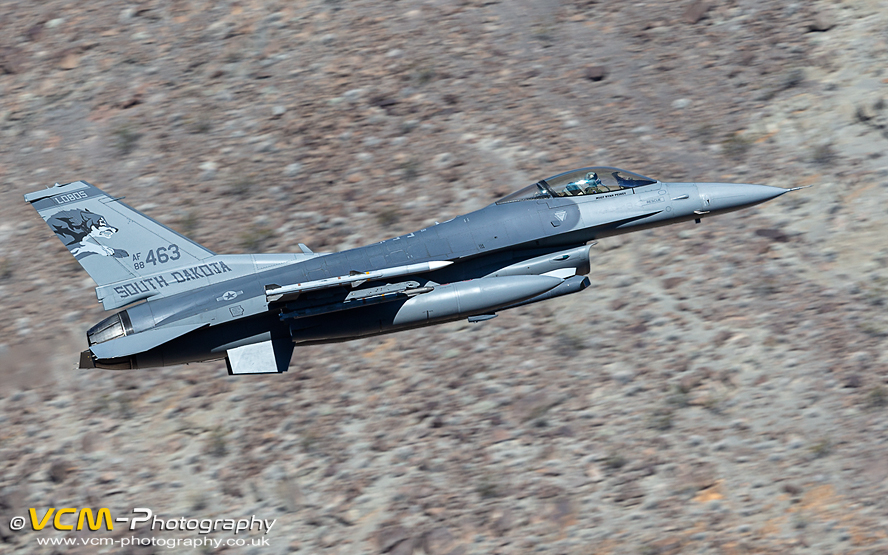 General Dynamics F‑16C, Block 40C Fighting Falcon. South Dakota ANG, 114th FW/175th FS.
General Dynamics F‑16C, Block 40C Fighting Falcon. South Dakota ANG, 114th FW/175th FS.
F‑16 models are denoted by increasing block numbers to denote upgrades, with block numbers covering both single and two‑seat versions.
In 1984 the F‑16A and B models were superseded by the F‑16C (single‑seat) and F‑16D (two‑seat)
variants, with deliveries beginning at Block 25. The first flight of a Block 25 F‑16C was in June 1984, with the variant entering USAF service
in September of the same year.
The F‑16 has a cropped delta‑wing, incorporating wing‑fuselage blending (no clear dividing line between wings and fuselage)
and forebody vortex‑control strakes, with a conventional tri‑plane tail assembly with all‑moving horizontal ‘stabilator’
tailplanes and a pair of ventral fins beneath the fuselage aft of the wings trailing edge. The single turbofan jet engine is fed via an underslung
air intake and splitter plate. The aircraft has a tricycle landing gear configuration with an aft‑retracting nose gear. There is a
boom‑style aerial refuelling receptacle aft of the single‑piece bubble canopy of the cockpit. Split‑flap air brakes
are located at the aft end of the wing‑body fairing and a tailhook is mounted underneath the fuselage. A fairing under the tailplane can house
ECM equipment or a drag chute.
The F‑16 was the first production fighter designed to be slightly aerodynamically unstable, also known as relaxed static stability (RSS)
to improve manoeuvrability. This creates an aircraft which is inherently unstable and wants to depart from controlled flight and without the
quadruplex fly‑by‑wire flight control system (FLCS) and flight computer (FLCC) would be impossible to be flown manually.
The F‑16 has no mechanical linkages between the pilot's control stick and rudder pedals to the flight control surfaces but relies
on electrical systems to relay the flight commands.
The F‑16 was designed to be relatively inexpensive to build and simpler to maintain than earlier‑generation fighters. Advanced
aerospace science and proven reliable systems from other aircraft such as the F‑15 and F‑111 were selected. These were combined
to simplify the aeroplane and reduce its size and weight, maintenance costs and purchase price.
The light weight of the fuselage is achieved without reducing its strength. The airframe is built with 80% aviation‑grade aluminium
alloys, 8% steel, 3% composites and 1.5% titanium. The number of lubrication points, fuel line connections and replaceable modules
has been significantly reduced, while the number of access panels which can be accessed without the need of stands has been increased over previous
aircraft types.
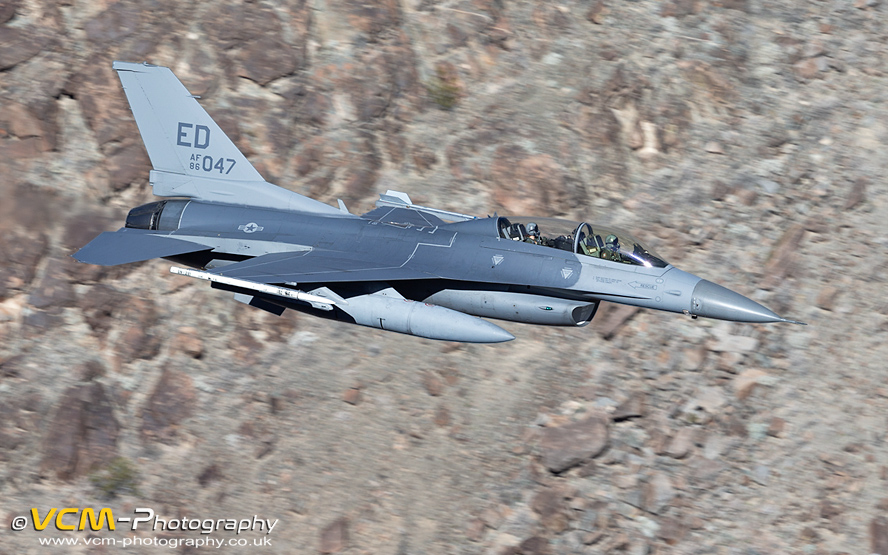 General Dynamics F‑16D, Block 30D Fighting Falcon, USAF 416th FLTS, Edwards Air Force Base.
General Dynamics F‑16D, Block 30D Fighting Falcon, USAF 416th FLTS, Edwards Air Force Base.
The cockpit has a single‑piece bird‑proof polycarbonate bubble canopy, providing 360° all‑around visibility,
with the pilot sitting in an ACES II zero/zero ejection seat which is reclined at a tilt‑back angle of 30° to help increase
g‑force tolerance.The pilot flies the aircraft primarily by means of an armrest‑mounted side‑stick controller (instead of a
conventional centre‑mounted stick), an engine throttle and conventional rudder pedals. Critical switches and buttons for the core control
of the aircraft are placed on the throttle and stick. This configuration known as hands on throttle‑and‑stick (HOTAS) allows
the pilot to perform all the vital functions without having to remove their hands from the controls, which enhances the pilot's degree of control
during high‑g combat manoeuvres. Since the introduction of the F‑16, HOTAS controls have become a standard feature on modern
fighters.
Flight information is projected onto a head‑up display (HUD) which helps the pilot's situational awareness by keeping their head
“out of the cockpit” while additional flight and systems information is displayed on multi‑function displays (MFD).
Navigation is provided by a highly accurate enhanced global positioning and inertial navigation system (EGI). Block 40 upgrades added
night‑vision goggles (NVG) capability, and Block 50/52 upgrades the Boeing Joint Helmet Mounted Cueing System (JHMCS)
to the pilot's arsenal of tools.
The F‑16 was originally powered by a Pratt & Whitney F100‑PW‑200 afterburning turbofan, but due to issues was replaced
by the F100‑PW‑220. This new engine had a Digital Electronic Engine Control (DEEC) unit which improved reliability.
As a result of the USAF's Alternate Fighter Engine (AFE) programme (known as the “Great Engine War”) the
F100‑PW‑220/220E was introduced and General Electric also became a F‑16 engine provider with its F110‑GE‑100.
Block numbers enable one to distinguish between aircraft equipped with these two engines and their required inlet ducts. From Block 30 series on,
blocks ending in “0” (e.g. Block 30) are powered by General Electric and blocks ending in “2” (e.g. Block 32)
are fitted with Pratt & Whitney engines.
The latest engines used by the F‑16 are:
Block 50 aircraft ‑ General Electric F110‑GE‑129, producing 17,155 lbf (76.3 kN) at intermediate power and 29,588 lbf
(131.2 kN) with full afterburner.
Block 52 aircraft ‑ Pratt & Whitney F100‑PW‑229, producing 17,800 lbf (79.2 kN) at intermediate power and 29,160 lbf
(129.7 kN) with full afterburner.
The F‑16 has a top speed of 1,500mph (Mach 2 at altitude), service ceiling above 50,000ft and a ferry range of over 2,0002 miles
(1740 nautical miles). The aircraft can carry various air‑to‑air, air‑to‑ground missiles, rockets or bombs,
electronic countermeasures (ECM), navigation, targeting or weapons pods and fuel tanks on nine hardpoints ‑ six under the wings,
two on the wingtips and one under the fuselage. Two additional locations under the fuselage are available for sensor or radar pods. The aircraft also
has an internal M61 20mm Vulcan cannon with 500 rounds located in the port side wing root.
In the early 1970's the United States Navy under the ‘Naval Fighter-Attack Experimental’ (VFAX) programme
was looking to procure a multirole combat aircraft to replace the Douglas A-4 Skyhawk, Vought A-7 Corsair II and McDonnell
Douglas F‑4 Phantom II's. Also the Navy's primary air superiority fighter//fleet defence interceptor, the Grumman
F‑14 Tomcat, though very capable was a very expensive aircraft to operate and Congress had mandated that the Navy pursue a lower
cost alternative.
Around the same time, the United States Air Force had initiated the ‘Lightweight Fighter’ (LWF) Technology
Evaluation programme to look at the concept of a light-weight fighter, which would be highly manoeuvrable with a high thrust‑to‑weight
ratio. The programme resulted in the development of the General Dynamics YF‑16 and Northrop YF‑17 (Cobra).
The Navy was directed to evaluate the two aircraft and though the single-engine YF‑16 won the LWF competition and went into service
with the Air Force as the F-16 Fighting Falcon, the Navy opted for the twin-engine YF‑17 after Northrop teamed
with McDonnell Douglas to produce a heavily re-designed version called the F/A-18 Hornet. The F/A-18 designation means
the aircraft was designed to be both a fighter and an attack aircraft. The single‑seat variant was designated F/A-18A and the
two-seat variant, F/A-18B. The two-seat F/A-18B was designed to be fully combat-capable, but was used primarily
for training.
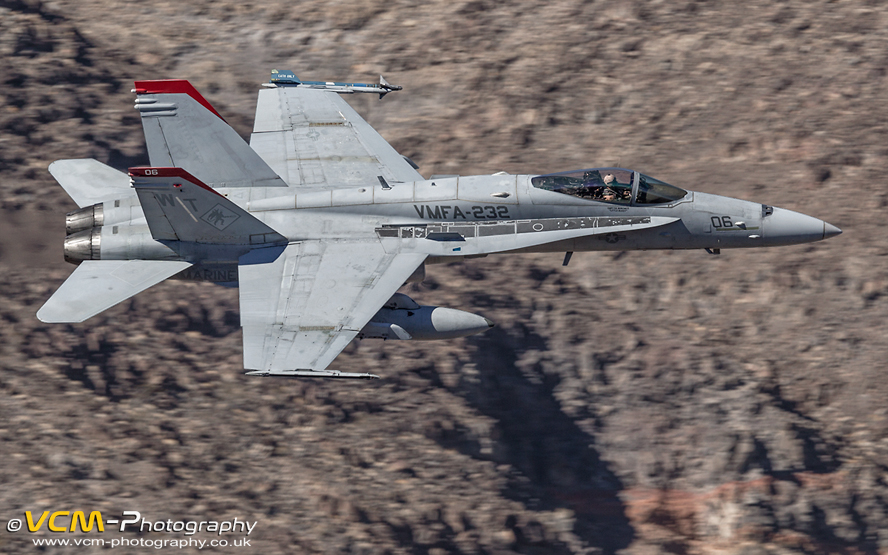 McDonnell Douglas F/A-18C Hornet of VMFA-232 ‘Red Devils’, Marine Fighter Attack Squadron, United States Marine Corps.
McDonnell Douglas F/A-18C Hornet of VMFA-232 ‘Red Devils’, Marine Fighter Attack Squadron, United States Marine Corps.
The F/A-18 Hornet first flew in November 1978, entering service with the United States Navy in November 1983 and the
United States Marine Corps in January 1984, with the aircraft becoming the Navy's main fighter aircraft as the F‑14 Tomcat was
relegated to the interceptor role.
The F/A-18 though similar in appearance to the YF-17 with its canted vertical stabilizers is a vastly different aircraft.
The airframe and landing gear are strengthened, with the addition of wing-fold mechanisms, a tailhook and catapult attachments
for carrier operations. The aircraft is highly manoeuvrable, with its two General Electric F404-400 engines giving a high
thrust‑to‑weight ratio. The engines were designed with operability, reliability and maintainability first and though their performance
is unexceptional, they are robust and resistant to stall and flameout. A digital fly‑by‑wire control system with quadruple redundancy
(the first to be installed in a production fighter) and leading‑edge extensions (LEX) allow the aircraft to remain controllable
at high angles of attack.
The Hornets primary missions are fighter escort, fleet air defence, suppression of enemy air defences, air interdiction, close air support
and aerial reconnaissance. The aircraft has a head-up display and multi-function CRT displays, the latter which allow the pilot
to easily transition between fighter or attack roles, or perform both.
The Hornet can carry a variety of bombs and missiles, including air‑to‑air and air‑to‑ground ordnance,
supplemented by a 20mm M61 Vulcan cannon.
In 1987 McDonnell Douglas (the prime contractor) introduced the single‑seat F/A-18C and two-seat F/A-18D
(the latter can be configured for training or as an all-weather strike aircraft). The F/A-18C and D had upgraded
radar, avionics, improved night attack capabilities and the capacity to carry a new range of air‑to‑air and
air‑to‑ground missiles, while uprated F404‑GE‑402 engines gave a 10% increase in static thrust.
The F/A‑18 has a top speed of Mach 1.8 (1,190mph or 1,914km/h) at 40,000ft (12,200m) with
a range of 1,089nm (2,017km). The aircraft has nine hardpoints, two on the wingtips, four underwing and three
under the fueslage, with a capacity of 13,700lb (6,200kg) for external fuel or ordnance.
The F/A-18 Hornet saw combat during the 1986 bombing of Libya, the 1990/1991 Gulf War, the 2003 Iraq War, the Balkans
and Afghanistan.
Though the United States Navy retired the F/A-18C from combat roles in April 2018, the United States Marine Corps plan to use the
F/A-18C/D till the 2030's, when it will be replaced by the F-35B and F-35C.
The Super Hornet is a twin‑engine, carrier‑capable, multirole fighter aircraft.
Designed and initially built by McDonnell Douglas (now a part of the Boeing Company after the merger in August 1997) the Super Hornet
first flew in November 1995, with full production beginning in September 1997. The aircraft entered service with the United States Navy
in 2001, working alongside the existing F/A-18C/D ‘Legacy’ Hornet and as a replacement for the Grumman F‑14 Tomcat
which was retired in 2006.
The single seat version of the Super Hornet is known as the F/A-18E and the two‑seat version the F/A-18F, the latter
having a second crew member in the role of Weapons Systems Officer (WSO).
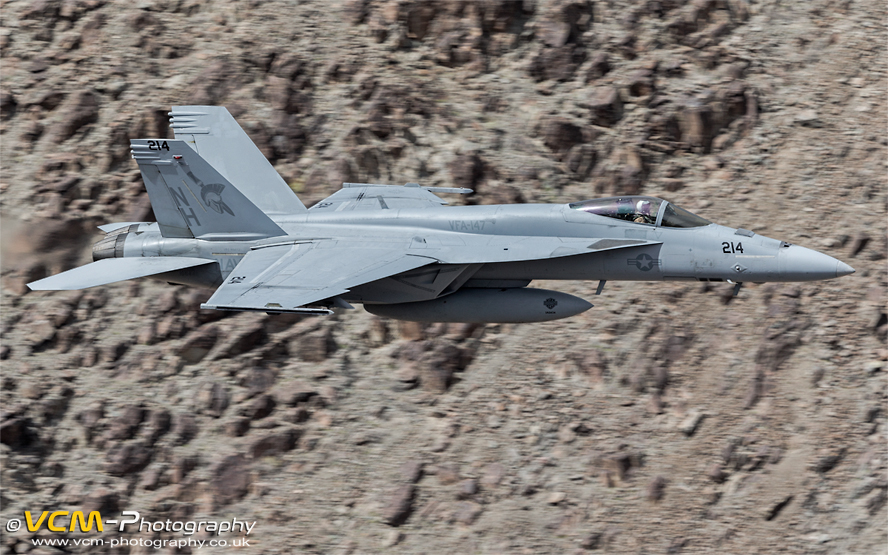 Boeing F/A-18E Super Hornet of VFA‑147 ‘Argonauts’, Strike Fighter Squadron, United States Navy.
Boeing F/A-18E Super Hornet of VFA‑147 ‘Argonauts’, Strike Fighter Squadron, United States Navy.
Though similar in appearance to the ‘Legacy’ Hornet, the Super Hornet is larger with a heavier maximum weight, but has fewer parts
and lower maintenance demands. The aircraft incorporates radar cross‑section reduction measures, notably at the front and rear of the aircraft.
The design of the engine inlets reduce the aircraft's frontal cross‑section, while the use of perforated panels which appear opaque
to radar waves at the frequencies used, replace grilles covering various exhaust and inlet ducts. The fuselage has been stretched by
34in (86cm) to make room for more fuel and avionics upgrades. The aircraft can carry 33% more fuel, increasing mission range
by 41% and endurance by 50%. The wing area has been increased by 25% with two extra wing hardpoints for payload
(for a total of 11), retaining hardpoints on the bottom centreline, wingtips and two conformal fuselage positions.
Re‑designed large rectangular air intakes increase airflow into new General Electric F414‑GE‑400 turbofans, which produce
22,000lbs maximum thrust, an increase of 35% over the ‘Legacy’ Hornet which enable the Super Hornet to match the C/D models
top speed of Mach 1.8 (1,190mph or 1,915km/h) at 40,000ft (12,190m).
The Super Hornet has an internal 20mm M61 rotary cannon and can carry a variety of air‑to‑air missiles and air‑to‑surface
weapons and can return to an aircraft carrier with a larger load of unspent fuel and munitions than the ‘Legacy’ Hornet. This load
which is known as ‘bringback’ is in excess of 9,000lbs (4,100kg). Unlike the ‘Legacy’ Hornet, the Super Hornet
can also be configured as an airborne tanker by adding an external air refuelling system.
Initially the Super Hornet retained the mission software and majority of avionics found in the C/D models, but this has been upgraded
significantly over time, such as the aircrafts defensive countermeasures and radar system. The Super Hornet has a quadruplex digital
fly‑by‑wire system as well as a digital flight‑control system that can detect and correct battle damage. In the cockpit
differences include a colour digital map, a touch‑sensitive control display, a larger multi‑purpose liquid crystal
colour display which shows tactical information, two monochrome displays and a new engine fuel display. In May 2007 the Joint Helmet Mounted
Cueing System ((JHMCS) was introduced which provides multi‑purpose situational awareness and high‑off foresight
missile cueing.
As the Super Hornet is significantly heavier than the ‘Legacy’ Hornet, the catapult and arresting systems for carrier deck operations
must be set differently. To aid safe flight operations and avoid confusion in radio calls, the Super Hornet is unofficially referred to
as the ‘Rhino’ to distinguish it from the earlier C/D models.
In 2020 the United States Navy Blue Angels Flight Demonstration Squadron which had flown the ‘Legacy’ Hornet since 1984 transitioned
to the Super Hornet.
The Growler is an American carrier‑based electronic warfare aircraft, a specialised version of the two‑seat F/A‑18F
Super Hornet. The aircraft has crew of two, with the second crew member being an Electronic Warfare Officer (EWO).
The first test aircraft known as an EA‑1 made its maiden flight in August 2006. Production started of the type in 2007
with the aircraft entering operational service with the United States Navy in September 2009, eventually replacing the Northrop Grumman
EA‑6B Prowler which was retired from service in June 2015.
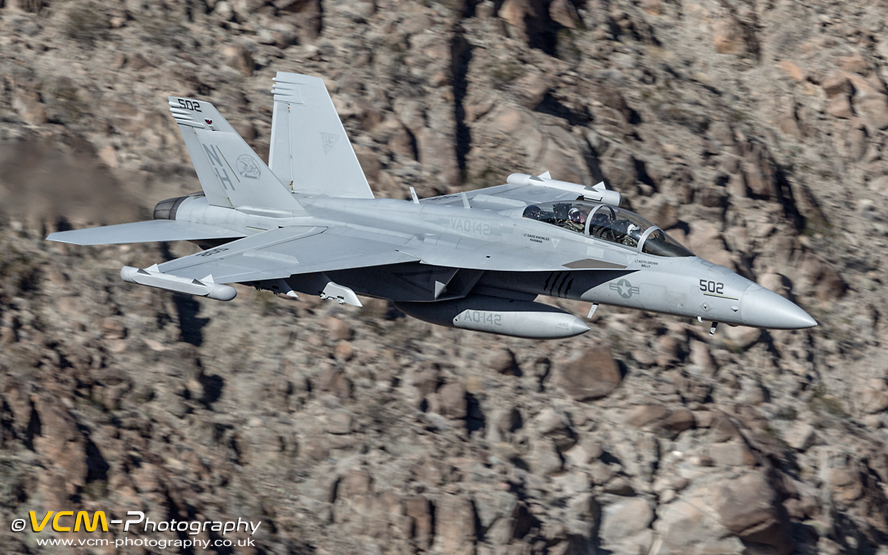 Boeing EA-18G Growler of VAQ‑142 ‘Gray Wolves’, Electronic Attack Squadron, United States Navy.
Boeing EA-18G Growler of VAQ‑142 ‘Gray Wolves’, Electronic Attack Squadron, United States Navy.
The Growler has more than 90% in common with the F/A‑18F Super Hornet, such as the airframe, radar and weapons systems. The flight
performance being similar also allows the Growler to perform escort jamming, as well as the traditional standoff jamming missions (radar jamming
and deception) and the ability to accompany Super Hornets during all phases of an attack mission.
The aircraft has nine weapons stations free (six under the wing and three under the fuselage) to provide additional weapons or
jamming pods, but most of the dedicated airborne electronic attack equipment is mounted on the aircrafts wingtips and in the space which was occupied
by the internal 20mm canon.
The AN/ALQ‑218 wide band receivers on the wingtips, the underwing mid‑board pylon mounted AN/ALQ‑99 high‑band
jamming pods and the centreline fuselage mounted AN/ALQ‑99 low‑band jamming pod are able to provide detection and jamming
against all known surface‑to‑air threats.
Under the fuselage the two multi‑mode conformal stations can hold AIM‑120 AMRAAM missiles, with the remaining inboard underwing pylons
available for 480 gallon fuel tanks, with the outboard pylons reserved for AGM‑88 HARM missiles.
The F‑15 Eagle is an American twin‑engine, all‑weather tactical fighter aircraft designed by McDonnell Douglas (now Boeing).
The aircraft which has been in service since the early 1970's is considered to be the most successful modern fighter aircraft, with over
100 victories (majority of victories by the Israeli Air Force) and no losses in aerial combat.
The origins of the F‑15 Eagle date back to the USAF's need for a dedicated air superiority fighter after the losses suffered during
the Vietnam war. Fighters of that era had been designed to engage opponents using air‑to‑air missiles launched at range and it was assumed
that close‑range dogfighting was a thing of the past. But there was a serious issue with the reliability and performance of the air‑to‑air
missiles of the time. Over one‑half of the missiles fired by the USAF during the Vietnam war malfunctioned and those that did work only had a hit
ratio of 1:11. As a result, jets like the F‑4 Phantom which had been built without an internal cannon and lacked the manoeuvrability of their
more agile opponents, such as the MiG‑17 and MiG‑21, found themselves at a serious disadvantage in slow‑speed turning fights.
Due to the unacceptable losses in Vietnam, it was realised that a dedicated air superiority fighter was needed. The fighter would need to be fast, have
a powerful radar, carry a large complement of air‑to‑air missiles, have a gun and be highly manoeuvrable for close‑range fighting
with other jets.
In 1965, the Department of Defence Research and Engineering bagan studies for an F‑X (meaning “Fighter, Unknown’ designation
number ‑ not “Fighter‑Experimental” as sometimes misinterpreted).
The necessity for a dedicated air superiority fighter was further enhanced in 1967 when Russia revealed the MiG‑25 Foxbat, a high‑speed,
high‑altitude interceptor. The MiG had similar design qualities as proposed for America's F‑X fighter programme. With a top speed
of Mach 2.8 and a large wing area, the American's were worried that not only was it very fast, but it was highly manoeuvrable, making it superior
to the F‑X. As a result, efforts were made to improve the F‑X design.
(The American's were later to discover the MiG‑25 was not the aircraft they feared it to be, when in September 1976 Lt. Victor Belenko
defected, by flying his MiG‑25 from Chuguyevka Air Base, north of Vladivostok, to Hakodate Airport in Japan. American analysts soon determined
that the MiG‑25, though very fast, was no dogfighter and that it had been designed and built for one purpose only: to intercept
high‑speed American bombers).
In September 1968, the USAF High Command and Tactical Air Command (TAC) eventually agreed that a pure air superiority fighter was required
over a multipurpose aircraft and a request for proposals was released to aerospace companies. The requirements called for a single‑seat,
twin‑engine fighter, having a maximum take‑off weight of 40,000 pounds (18,000kg) for the air‑to‑air role, with a
maximum speed of Mach 2.5 and a thrust‑to‑weight ratio of nearly 1:1 at mission weight.
In December 1969 it was announced that McDonnell Douglas was awarded the winning design. The first flight of the new fighter, designated
F‑15A‑1 (Serial No. 71‑0280) was made in July 1972 and a two‑seat training version,
F‑15B‑1 (Serial No. 71‑0290 ‑ formerly designated a TF‑15A) in July 1973. Between 1972 to 1979,
384 F‑15A's and 61 F‑15B's were built.
In November 1974 the first operational F‑15 was delivered to the 555th Tactical Fighter Training Squadron at Luke Air Force Base (AFB),
Arizona, where training began on both the F‑15A and F‑15B aircraft. In January 1976 the first F‑15 destined for a combat
squadron was delivered to the 1st Tactical Fighter Wing at Langley AFB, Virginia.
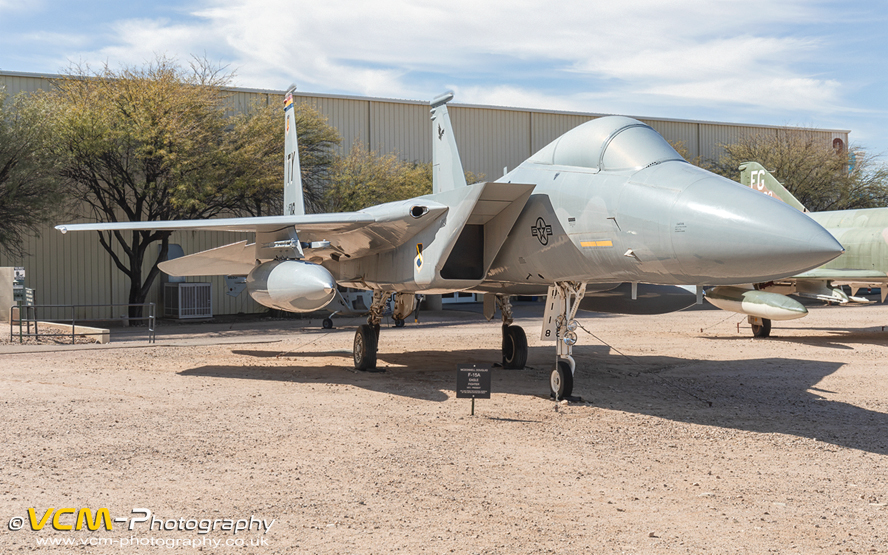 McDonnell Douglas F-15A Eagle at the Pima Air & Space Museum, Tuscon, Arizona, USA.
McDonnell Douglas F-15A Eagle at the Pima Air & Space Museum, Tuscon, Arizona, USA.
Displayed in the markings of the 325th Tactical Fighter Wing, Tyndall Air Force Base, Florida.
The F‑15 Eagle has an all‑metal semi‑monocoque, flat, wide fuselage, that also provides an effective lifting surface, to which
is attached a large‑cantilever shoulder‑mounted wing. The tail assembly has two vertical stabilizers with all‑moving horizontal
stabilizers that can move independently of one‑another to provide roll in some flight manoeuvres. The aircraft has a spine‑mounted
airbrake and retractable tricycle landing gear.
Propulsion on the F‑15A and F‑15B was supplied by two mounted side‑by‑side Pratt & Whitney F100‑PW‑100
afterburning turbofan engines, fed by intake ramps. Each engine was rated at 14,690 lbf (65.3 kN) military power and
23,930 lbf (106.4 kN) in full afterburner, giving the aircraft a top speed of 1,875mph (Mach 2.5 plus) and
maximum ceiling of 65,000ft (19,697m).
The F‑15 Eagle cockpit is mounted high in the forward fuselage with a one‑piece windscreen and large canopy for increased visibility,
allowing a 360‑degree field of view. The pilot has hands on throttle‑and‑stick (HOTAS) and a head‑up display (HUD)
which displays continuous attitude, altitude, heading, airspeed and targeting symbols for weapons launch. The APG‑63 pulse‑Doppler radar,
heavily automated, could look up at high‑flying targets and down at low‑flying targets without being confused by ground clutter.
The F‑15A was armed with: One internally mounted M61A1 20mm six‑barrel rotary cannon with 938 rounds of ammunition; four AIM‑7F
Sparrow radar‑guided missiles and four AIM‑9 Sidewinder heat‑seeking missiles carried externally. It could also be armed with
Mk. 82 500lb or Mk. 84 2,000lb bombs.
In September 2009 the last F‑15A was retired from the Oregon Air National Guard (ANG), marking the end of service life for the F‑15A
and F‑15B in the United States.
In June 1979 the new single‑seat F‑15C and two‑seat F‑15D models began entering service. Though externally identical to the A and B models, they had significant changes to the internal systems. Between 1979 and 1985, 483 F‑15C's and 92 F‑15D's were built.
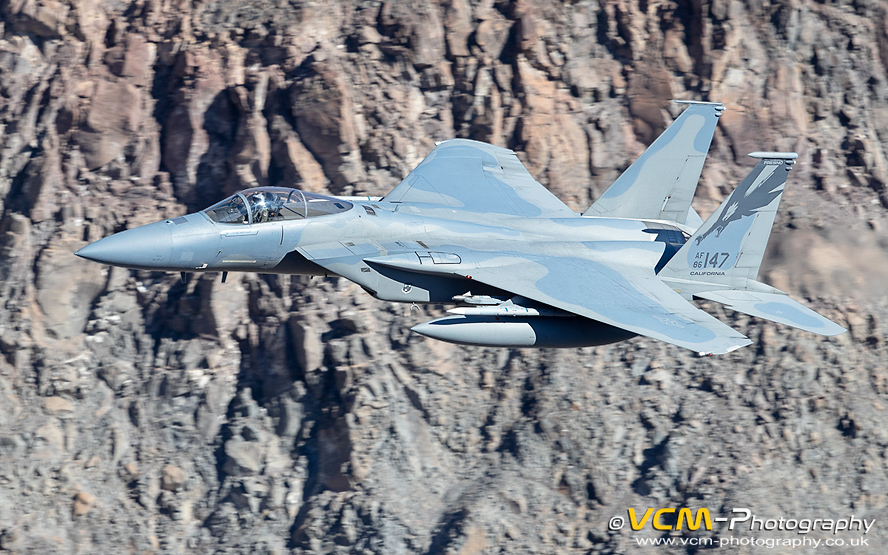 McDonnell Douglas F-15C Eagle of the 144th FW/195th FS ‘Griffins’ California Air national Guard.
McDonnell Douglas F-15C Eagle of the 144th FW/195th FS ‘Griffins’ California Air national Guard.
The new models had the Production Eagle Package (PEP 2000) improvements, which included 2,000lb (900kg) additional fuel, provision
for carrying external conformal fuel tanks and an increased maximum take‑off weight up to 68,000lbs (30,600kg). The undercarriage was
strengthened accordingly. The biggest change was to the APG‑63 radar, which was improved by a Programmable Signal Processor (PSP), the
first of its kind, which enabled the radar to be reprogrammable for the addition of new armaments and equipment.
Additional improvements continued with the F‑15 Multistage Improvements Programme (MSIP) initiated in February 1983, with the first
production MSIP F‑15C introduced in 1985. Improvements included an upgraded central computer, a programmable Armament Control Set which allowed
for the use of more advanced air‑to‑air missiles such as the AIM‑7 Sparrow, AIM‑9 Sidewinder and AIM‑120.
(The AIM‑120 or AMRAAM is a beyond visual‑range air‑to‑air missile capable of all‑weather day‑and‑night
operations. Unlike previous generation Sparrow missiles, it is a fire‑and‑forget missile, where no guidance is needed from the
firing aircraft). Updates were also made to the Tactical Electronic Warfare System that provided improvements to the radar warning receiver and
electronic countermeasures (ECM) jamming system.
In 1986, due to reliability, maintenance costs and service life of the Pratt & Whitney F100‑PW‑100 engines, the new
Pratt & Whitney F100‑PW‑220 engine was introduced and began to be installed or gradually replaced on all new F‑15's. The new
engine incorporated a digital electronic engine control (DEEC) which integrated a variety of engine functions to improve performance
and extend engine life. Rated at 14,590 lbf (64.9 kN) military power and 23,770 lbf (105.7 kN) in full afterburner the
F100‑PW‑220 engine has slightly less thrust than the F100‑PW‑100 engine, but has greater dynamic thrust across most of the
power envelope which can propel the aircraft to a maximum speed of Mach 2.54 (1,650mph or 2,655km/h) at high altitude and Mach 1.2
(921mph or 1,482km/h) at sea level.
In 2007 some F‑15C's were equipped with the Joint Helmet‑Mounted Cueing System (JHMCS). In the latter years of production
the last 43 F‑15C's built were upgraded with the APG‑70 radar and later the APG‑63(V) radar. The APG‑63(V1)
radar provided an increase in reliability and performance, being able to track 14 targets simultaneously, while being able to simultaneously
attack 6 of those.
The F‑15C has a combat range of 1,221 miles (1,965km) for interdiction missions and with conformal fuel tanks and three external
fuel tanks a ferry range of 3,500 miles (5,600km). Armament consists of: One internally mounted M61A1 20mm six‑barrel rotary cannon
with 940 rounds of ammunition; four AIM‑9 Sidewinder heat‑seeking missiles and four AIM‑7 Sparrow radar‑guided missiles,
or a combination of AIM‑9, AIM‑7 and AIM‑120 beyond visual‑range air‑to‑air missiles carried externally.
The USAF (as of April 2023) still operates the F‑15C/D, though its role is gradually being replaced by the
F‑35 Lightning II.
Other F‑15A/B/C/D operators:
• Israeli Air Force (IAF) has operated F‑15's since 1977. The IAF has 84 F‑A/B/C/D/I aircraft
in service as of 2022.
• Japan Air Self Defense Force has operated Mitsubishi F‑15J (single‑seat) and F‑15DJ's
(two‑seat trainer) variants since 1981. The aircraft are produced under license by Mitsubishi Heavy Industries.
• Royal Saudi Air Force has operated F‑15C/D's since 1981.
The A‑10 Thunderbolt II is a single‑seat, twin‑turbofan, subsonic attack aircraft designed by Fairchild Republic
for the United States Air Force (USAF). The primary mission of the aircraft, which is called the “Warthog” by pilots
and ground crew is to provide close air support (CAS) to friendly ground troops by attacking enemy armoured vehicles, tanks, and
ground forces. Its secondary mission as an airborne forward air controller is to direct other aircraft in attacks on ground targets. Aircraft
used in this role are designated OA‑10.
The origins of the A‑10 date back to the Vietnam War. During the war, the U.S. military realised the need for a dedicated close air
support aircraft due to the heavy losses suffered by the Douglas A‑1 Skyraider. The proprellor‑driven A‑1 was the
main ground‑attack aircraft of the war and though it could carry a large payload and had a long loiter time it was slow and
vulnerable to ground fire. The U.S. lost 266 A‑1's during the war, largely from small arms fire.
In September 1966, the Attack Experimental (A‑X) programme office was formed after it was announced by the USAF that
a specialised CAS aircraft was required. In 1970, due to the Cold War threat of Soviet armoured forces the USAF issued a modified, more
detailed request for proposals (RfP) for the aircraft, stating that it should be designed specifically for the 30mm rotary cannon.
The RpF also specified a maximum speed of 460mph (400 knots or 740km/h), take‑off distance of 4000ft (1,200m),
external load of 16,000lbs (7,300kg) and a 285‑mile (460kn) mission radius.
Six companies submitted proposals for the new aircraft, out of which Northrop and Fairchild Republic were selected to build prototypes,
the YA‑9A and the YA‑10A respectively. The first of the two YA‑10A prototypes flew on the 10th May 1972, with the
YA‑9A prototype on the 30th of the same month. In January 1973 the USAF announced the selection of the YA‑10A for production.
The first production A‑10, designated A‑10A flew in October 1975, with the type achieving initial operating capability
(IOC) in October 1977.
Production of the A‑10 continued till 1984 with 715 aircraft being delivered, including two prototypes and six development aircraft.
The aircraft was originally manufactured by Fairchild Republic, now a part of Northrop Grumman, which has been the prime contractor
of the aircraft since 1987. Northrop Grumman has been performing support and structural upgrade programmes from the Integrated Systems
Aerostructures Divisions at Bethpage, New York; and St Augustine, Florida.
Since entering service, the A‑10 has received many equipment and system upgrades, such as the notable “HOG UP”
programme implemented in 1999 to address wing fatigue and increase the life span of the airframes. From 2005 to 2011 the entire
fleet of A‑10A's were modernised in the Precision Engagement Upgrade programme and redesignated A‑10C. In September
2007 the A‑10C with the precision Engagement Upgrade reached IOC.
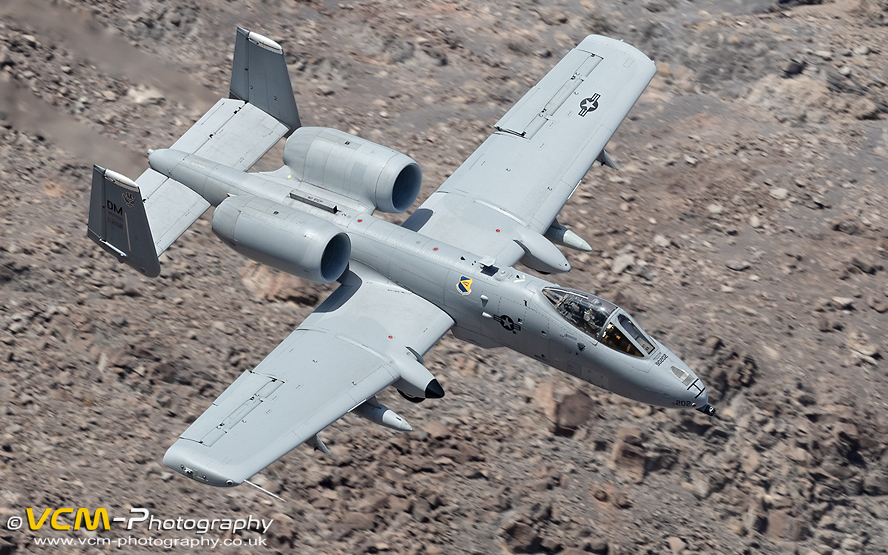 Fairchild Republic A‑10C of the USAF 357th Fighter Sqn ‘Dragons’, Davis‑Monthan A.F.B. Arizona.
Fairchild Republic A‑10C of the USAF 357th Fighter Sqn ‘Dragons’, Davis‑Monthan A.F.B. Arizona.
The A‑10 has a large, straight, high‑aspect ratio wings and large ailerons, which give it excellent low‑speed,
low‑altitude manoeuvrability while maintaining a stable and highly accurate weapons delivery platform. The aircraft has a
short take‑off and landing capability and can land on unimproved surfaces which makes it ideal for operating from primitive
forward airfields near the front lines. The aircraft can be serviced and operated from such bases with limited facilities as many
of the aircraft's parts are interchangeable left and right, such as the engines, main landing gear and vertical stabilizers.
The wing skin is not load bearing, so damaged skin can easily be repaired in the field, and with makeshift materials if
necessary.
Working in the close air support role and the high risk of receiving ground fire, the A‑10 was designed for survivability.
The single‑seat cockpit and portions of its flight control system are protected by 1,200 pounds of titanium aircraft
armour (up to 3.8cm thick) called the “bathtub”, which can withstand direct hits from armour‑piercing
projectiles up to 23mm. A large bulletproof bubble canopy and front windscreen protects the pilot from small arms fire and affords
good all‑around vision. Self‑sealing fuel cells are protected by internal and external foam. Manual systems back
up their redundant hydraulic flight‑control systems, which permits the pilot to fly and land when hydraulic power is lost.
The cockpit is equipped with a head‑up display (used for targeting and weapon‑aiming), a Have‑Quick secure
radio communications system, inertial navigation, and a tactical air navigation (TACTAN) system. Upgrades included the
embedded global positioning system/inertial navigation system (EGI), which displays the exact position of the aircraft.
The pilot is also equipped with night‑vision goggles which allows the aircraft to conduct CAS during darkness.
The A‑10 is powered by two General Electric TF34‑GE‑100 non‑afterburning turbofan engines, each providing
9,065lb of thrust. They are located high on the fuselage and their position not only protects them from debris being picked‑up
from unprepared runways, but also directs their exhaust over the tailplane, helping to shield them from detection by
infrared surface‑to‑air missiles. The engines being positioned close together also makes flying the aircraft easier
if one fails. The A‑10 has a standard range of 800 miles (1,287km), a maximum speed of 420mph (375 knots or
676km/h) and a maximum ceiling of 45,000ft (13,636m).
For the CAS role, the A‑10's primary weapon is the General Electric GAU‑8/A Avenger hydraulically driven
seven‑barrel 30mm Gatling‑style autocannon, mounted in the nose of the aircraft. To accommodate the cannon which
accounts for approximately 16% of the A‑10's unladen weight, the aircraft front landing gear is offset to the
starboard side so that the cannon barrel is positioned on the aircraft centreline. The cannon, which is extremely accurate can fire
3,900 rounds a minute (but is only armed with 1,150 rounds) and can disable a main battle tank from a range of more
than 6,500 metres.
In addition to the cannon, the A‑10 can carry 16,000lbs (7,200kg) of mixed ordnance on eight under‑wing and
three under‑fuselage pylon stations. This can include an array of air‑to‑surface weapons, including laser
and GPS guided munitions, AGM‑65 Maverick, and AIM‑9 Sidewinder missiles. For protection the aircraft carries infrared
and electronic countermeasures against surface‑to‑air threats, both missile and anti‑aircraft artillery.
The A‑10 has participated in the following operations: Desert Storm (Gulf War 1990 to 1991), Southern Watch
(Iraq, 1992 to 2003), Provide Comfort (Iraq, 1991 to 1996), Desert Fox (Iraq, 1998), Noble Anvil
(Yugoslavia, 1999), Deny Flight (Bosnia, 1993 to 1995), Deliberate Force (Bosnia, 1995), Allied Force
(Yugoslavia, 1999), Enduring Freedom (Afghanistan, 1991 to 2014) and Iraq Freedom (Iraq, 2003 to 2011).
In recent years the USAF has had multiple attempts to retire the A‑10, stating that the ageing aircraft is difficult to
maintain and would rather allocate the funds for its maintenance and upkeep to procure modern aircraft. The problem is that no
other aircraft in the USAF inventory can perform CAS like the A‑10 and to develop a replacement would waste substantial
resources and seriously impair U.S. military capabilities, so its highly likely the A‑10 will be around till its end
of service life in 2035.
The Lockheed Martin F‑35 Lightning II, is an American fifth‑generation, single‑seat, supersonic, single‑engine,
all‑weather stealth multirole fighter, designed to perform ground‑attack and air superiority missions. It can also provide
electronic warfare and intelligence, surveillance and reconnaissance capabilities. The F‑35 is produced in three different versions,
with the primary users being the U.S. Air Force, Marine Corps and Navy. It is also exported.
The F‑35 Lightning, has the most advanced computers and networking abilities as‑to‑date of any aircraft to take to the air.
Its advanced sensors and mission systems with stealth capability, enable it to operate undetected in hostile airspace. Integrated sensors,
sensor fusion and data linking provide the pilot with unprecedented situational awareness, who is then able to share information gathered
by the aircraft with other platforms using secure data links and/or use the information to employ weapons or electronic means.
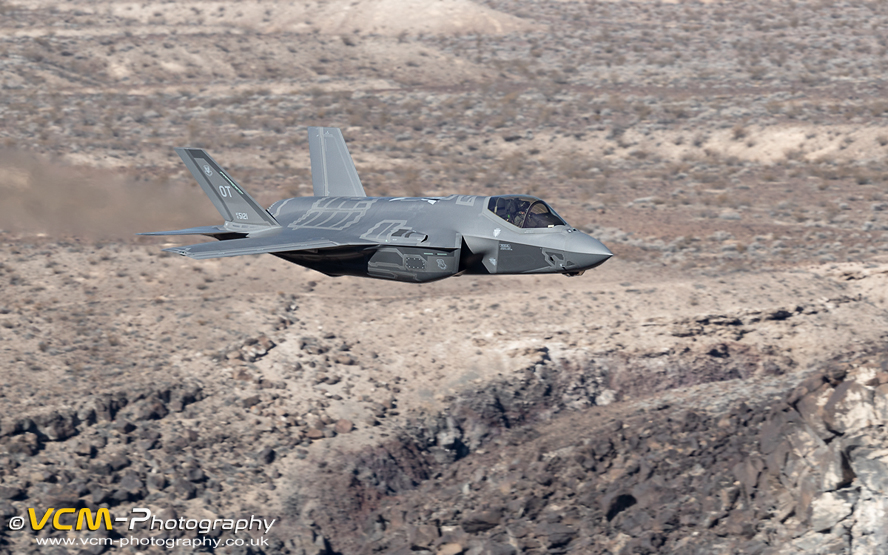 Lockheed Martin F‑35A Lightning II of 31st Test & Evaluation Squadron, United States Air Force.
Lockheed Martin F‑35A Lightning II of 31st Test & Evaluation Squadron, United States Air Force.
The F‑35 Lightning is the product of the Joint Strike Fighter (JSF) programme, which originated from several U.S. military
programmes conducted during the 1980's and 1990's. The focus of these early programmes included: Finding a stealthy replacement for the U.S.
Navy A‑6 Intruder. Develop a successor to the Harrier jump jet for the U.S. Marine Corps and the U.K. Royal Navy. This latter programme
had a separate classified programme looking into a stealthy supersonic STOVL fighter intended for both the U.S. Air Force (USAF)
and the U.S. Marine Corps (USMC). Through these programmes and other cancelled studies emerged the Joint Advanced Strike Technology
(JAST) programme, which was established in January 1994 to develop aircraft, weapons and sensor technology, with the aim of replacing
several disparate U.S. and U.K. aircraft with a single family of aircraft. The programme which was serving the USAF, USMC and USN, was renamed
the Joint Strike Fighter (JSF) programme in 1995. The JSF was expected to eventually replace large numbers of multi‑role and strike
fighter aircraft, such as the Harrier, F‑16, F/A‑18, A‑10 and F‑117.
Submissions to the JSF competition were made by Boeing, McDonnell Douglas, Northrop and Lockheed Martin. Boeing and Lockheed Martin were
selected in early 1997 with their concept demonstrator aircraft, designated X‑32 and X‑35 respectively (Lockheed Martin design
team were joined by Northrop Grumman and British Aerospace). Each company had to produce two prototypes to demonstrate conventional
takeoff and landing (CTOL), carrier takeoff and landing (CV) and short takeoff and vertical landing (STOVL).
In October 2001, Lockheed Martin was declared the winner of the JSF competition with their X‑35 and was awarded the System Development and
Demonstration (SDD) contract, with Pratt & Whitney awarded the development contract for the aircraft engine.
The Lockheed Martin X‑35, now renamed F‑35, was developed in co‑operation with international partners, such as the United Kingdom
(which joined the JAST programme in 1995, becoming the only Tier 1 partner), Italy, the Netherlands, Norway, Canada, Australia and Turkey
and so became available for export to these countries. The first flight of an F‑35 (F‑35A variant) was made on
15th December 2006.
The F‑35 is produced in three variants:
• F‑35A ‑ Conventional takeoff and landing (CTOL) variant for the U.S. Air Force (introduced into service,
August 2016). It is the smallest, lightest version of the F‑35 and the only one to be equipped with an internal cannon.
The GAU‑22/A 25mm cannon is designed for increased effectiveness against ground targets, compared to the 20mm M61 Vulcan cannon
carried by other USAF fighters. The F‑35A is primarily intended to replace the USAF's F‑16 Fighting Falcon. The aircraft
is designed to match the F‑16 in manoeuvrability and outperform it in stealth, payload, range on internal fuel, avionics, operational
effectiveness, supportability and survivability.
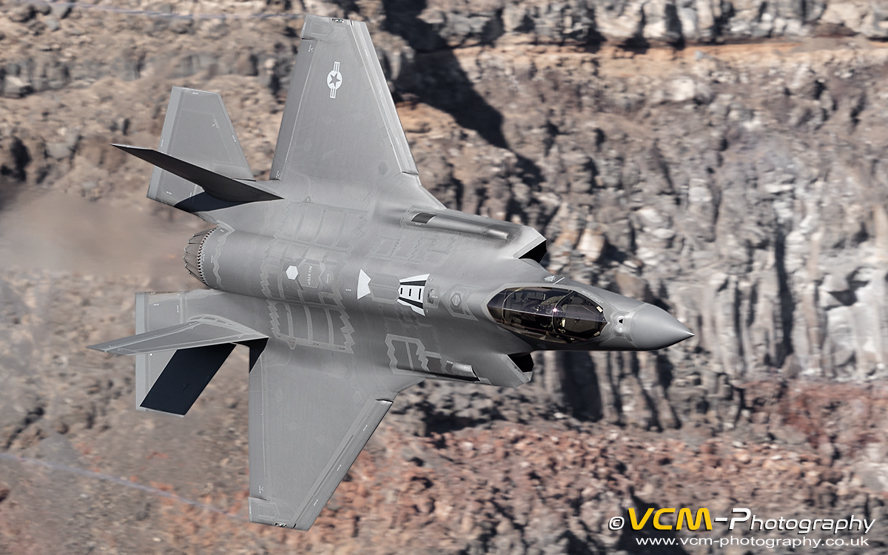 Lockheed Martin F‑35A Lightning II of 422nd Test & Evaluation Squadron, United States Air Force.
Lockheed Martin F‑35A Lightning II of 422nd Test & Evaluation Squadron, United States Air Force.
• F‑35B ‑ Short takeoff and landing (STOVL) variant (introduced into service, July 2017 with the U.S. Marine Corps). This variant is used by the U.S. Marine Corps and is intended to eventually replace the F/A‑18 Hornet (A, B, C and D‑models) and the AV‑8B Harrier II. The B variant is similar in size to the A variant, but sacrifices about a third of the A variant's fuel volume to accommodate the vertical flight system. The vertical flight system is composed of a thrust vectoring nozzle at the tail of the aircraft, which allows the main engine exhaust to be deflected downwards. At the front of the aircraft behind the cockpit is a Shaft‑Driven Lift Fan (SDLF), which can be engaged with the main engine via a clutch, providing a counterbalancing thrust. Roll control is achieved by diverting unheated engine bypass air through wing‑mounted thrust nozzles, called roll posts.
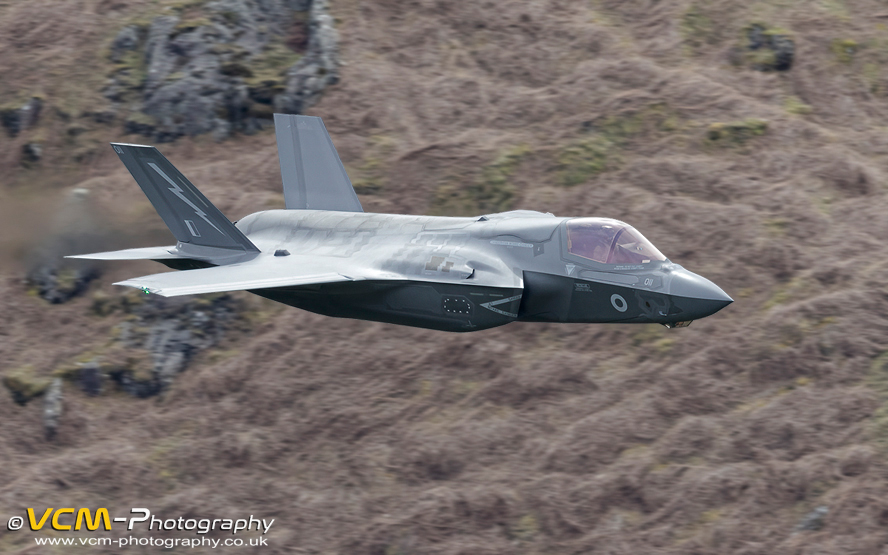 Lockheed Martin F‑35B Lightning of No. 207 Squadron, Royal Air Force.
Lockheed Martin F‑35B Lightning of No. 207 Squadron, Royal Air Force.
• F‑35C ‑ Carrier variant for the U.S. Navy (introduced into service, January 2018). This variant has larger wings with foldable wingtip sections, larger wing and tail control services for improved low‑speed control, stronger landing gear for the stresses of carrier arrested landings, a twin‑wheel nose gear and a stronger tailhook for use with carrier arrestor cables. The larger wing area allows for decreased landing speed, while increasing both range and payload.
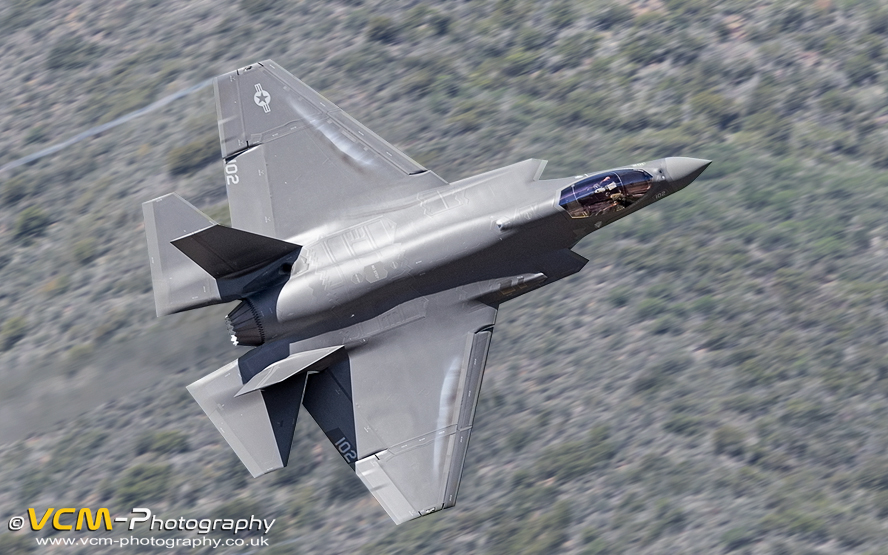 Lockheed Martin F‑35C Lightning II of VX‑9 ‘Vampires’, Air Test & Evaluation Squadron, United States Navy.
Lockheed Martin F‑35C Lightning II of VX‑9 ‘Vampires’, Air Test & Evaluation Squadron, United States Navy.
The F‑35 is powered by a single Pratt & Whitney F135 afterburner turbofan engine which was derived from the F‑22 Raptor, F119 engine.
The engine is rated at 27,000 lbf (120 kN) using military power and 43,000 lbf (182 kN) with full afterburner.
The F‑35A uses the F135‑PW‑100 variant, while the F‑35C naval variant uses the F135‑PW‑400 engine built with
salt‑corrosion resistant materials. The F135 engine gives all variants a maximum speed of over Mach 1.6, attainable with a full internal payload.
The engine gives good subsonic acceleration and enables the aircraft to fly briefly at Mach 1.2 for 150 miles without the use of afterburner.
The F135‑PW‑600 variant engine for the F‑35B incorporates a Shaft‑Driven Lift Fan (SDLF) to allow STOVL
operations. The system was designed by Lockheed Martin and developed and built by Rolls‑Royce as a subcontractor to Pratt & Whitney.
The F‑35 features a full‑panel width glass cockpit, designed to give the pilot good situational awareness. The main cockpit display
is a 20x8 inch panoramic touchscreen, which shows flight instruments, stores management, CNI (communications, navigation & identification)
information and integrated caution and warnings. The pilot is seated on a Martin‑Baker US16E ejection seat and controls the aircraft using
a right‑hand side stick and throttle (HOTAS). The F‑35 is the first operational aircraft to feature a cockpit
speech‑recognition (DVI) system, which is provided by Adacel. Flight and combat information is displayed on the visor of the pilot's
helmet, in a helmet‑mounted display system (HMDS). The HMDS, which replaces the standard head‑up display (HUD), gives the
pilot all the information, no matter which way he/she is facing. Infrared and night vision imagery can be displayed directly on the HMDS and enables
the pilot to see through the aircraft. The helmet also allows the pilot to fire missiles at targets, even when the nose of the aircraft is pointing
elsewhere.
The F‑35 has two internal weapons bays with four weapons stations, which can carry a variety of air‑to‑air missiles,
air‑to‑ground missiles and a mixture of small diameter bombs and anti‑tank missiles. The internal bays help preserve the
aircrafts stealth capabilities and reduce parasitic drag. The aircraft can use six external weapons stations for missions that do not require stealth.
These pylons can carry a variety of munitions and larger weapons, such as the AGM‑158 Joint Air to Surface Standoff Missile (JASSM)
cruise missile which would not fit inside the weapons bays.
To date (January 2023), the F‑35 has been exported and in‑service with the following air forces:
United Kingdom (RAF), Australia, Israel, Italy, Japan, Norway and the Netherlands.

